The secret to having a successful sailing cruising lifestyle is maintaining a routine of checks. Things break on a boat all the time when you first start out. Over time, however, you start to discover ways and means to prevent a majority of breakages – even checks concerning marine and boat refrigeration temperature come into play.
My husband, Simon, knows that our generator impeller always breaks (and we overheat) after X amount of hours. He, therefore, created a check to ensure that he changes the impeller a few hours before that limit. Since doing so we’ve avoided overheating.
When Simon and I took our Marine Diesel engine & ancillary systems course our teacher told us how he has little spots of red paint on his engine, generator, and even in his fridge. On a daily or weekly basis, he uses a temperature gun on the red spots to ensure that the temps are the same as usual. If and when he finds something too cold or too hot he knows there’s an issue to investigate.
It might seem like overkill but the longer you’re on a boat the more you realize how important preventative maintenance is.
Small little checks every day help keep big issues away.
One of the daily checks on our daily checklist is to monitor the marine and boat refrigeration temperature on our fridge and freezer. Just like looking at our battery-bank level, we cast a quick glance over our fridge and freezer temps every time we look at the gauges.
Many boat refrigeration systems are water-cooled. That means that part of their system uses seawater to aid in refrigeration. Changes in sea temperature cause changes in refrigeration temperatures. When we were in the Mediterranean we had our thermostats set to one setting and once we got to the Caribbean we had to drastically lower the setting.
Had I not been paying attention to the temperature when we crossed the Atlantic Ocean, and reduced it as we went, we could have had quite a bit of food spoil.
Some refrigeration systems are outside and if they’re in direct line with the sun or in an enclosed patio area they’ll start warming up too. Boat refrigeration thermostats don’t seem to keep a constant temperature – I’ve discovered that when we move to different locations I often have to play around with the thermostat for a couple of days to ensure things don’t freeze but they don’t get too warm either.
To get a 40° F (4° C) temperature reading at the bottom of my fridge in Charleston, South Carolina I had a very different thermostat setting than when we went to Grenada in the southern Caribbean.
Interestingly, when we’re on a long passage I often have to turn the thermostat up as things start to freeze. The reason being that we’re not opening the fridge as often as normal. Everyone is up in the cockpit chilling out rather than opening the fridge several times a day searching for a snack!
My main motivation for knowing what our fridge temperature comes down to food spoiling.
I don’t want it too warm so that meat or milk goes off but I don’t want it too high so that my carrots or cucumbers freeze.
Through trial and error, I’ve found that keeping the bottom of the fridge at 40° F (4° C) seems to work best. If I have meat, I keep it on the bottom. That’s also where the beer, wine, and milk go. In the middle of our fridge, I have our veggies. And at the top, I have cheeses, condiments, and yogurts.
For our freezer, which is a separate unit – it’s a chest freezer, I keep that around 0° F (-18° C). We have it on all day long using solar power and turn it off at night. We’re fortunate that it’s a very well insulated freezer and keeps a low temperature all night.
When we first got our boat we had temperature sensors outside the fridge and freezer. They were devices that had a wire leading into the fridge/freezer showing a temperature reading outside the unit. They stopped working after a while. We’d have to play with the battery for a while and it would work but then soon stop. I’m sure it’s due to corrosion. Everything on a boat corrodes – especially these tiny gauges that probably aren’t meant for sea air.
More recently, however, we found a new solution for keeping track of various temperatures.
A cruiser friend, Tim, told me about a Bluetooth solution for under $30.00 dollars. He explained that you can get a system with sensors to put anywhere you want. Then there is a master control panel that provides the temperatures and it’s all wireless.
Considering we’ve been in St Martin and it’s been easy to get Amazon deliveries, I went online to see what I could find. I purchased this system AMIR Indoor Outdoor Thermometer and have been very impressed. All I had to do was insert some batteries, put the sensors where I wanted them and then turn the system on.
We hung the temperature gauge on our Navigation Station wall and can now see the temps of the fridge, freezer, engine room, and ambient temp (temp in the boat) all in one place (see photos below). I didn’t think that the Bluetooth signal would make it through our very insulated freezer but it’s been working fine.
We can even set alarms if something gets too hot or too cold. And there are alerts if the humidity or temp is dropping/rising very fast!
When starting off as a sailing cruiser the lifestyle can seem very overwhelming. There is so much to learn and so much to take in. My suggestion is to start setting routines and have checklists for every system and activity you do on the boat. Have a system for leaving a marina, a checklist for engine checks, a set routine for pulling up a mooring ball, and so forth.
Every time Simon and I approach a mooring ball we know exactly how it’s going to go.
Simon is always going to approach the ball with the bow of the boat to the left of the ball. I’m always going to bend down just when we’re on top of it. Simon is always going to throw the boat in reverse just as I bend down and on the routine goes. We don’t have to say a word to each other because through trial and error we’ve created systems of success. We learned what doesn’t work (swearing at each other!) and what does (fine-tuning a set system).
If you’d like a copy of all the success systems that we use on Britican, you can get more information about that here: Checklists For Sailors – Passage Planning, Sailboat Maintenance, Cleaning, Medical, and more.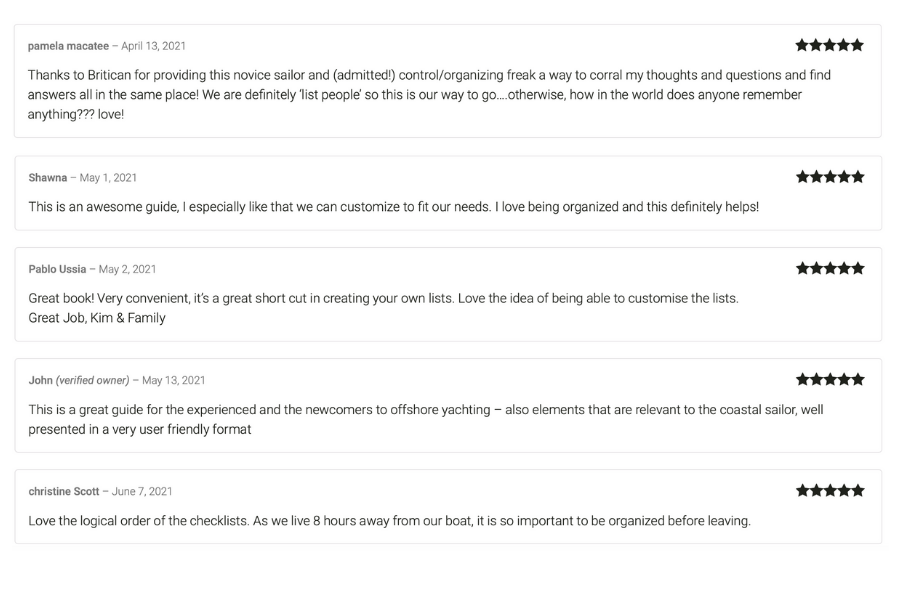
Fridge and freezer temperatures are just two of the tiny checks to make routine ensuring a proactive approach to preventive sailboat maintenance. Aside from these checks that you’re going to start doing, what other checks can you put in place to make your sailing life easier and less problematic?
Marine And Boat Refrigeration Temperature Gauge Pictures
- Temp Display On Nav Station
- Temp Gauge in Fridge
- Temp Gauge in Freezer
- Temp Gauge in Engine Room
Get more information on the AMIR Indoor Outdoor Thermometer here.
Other Articles/Videos You Might Like To Check Out
- Tips For Sailing Families
- Handling Boat Life Problems
- 10 Top Boat Life Tips
- Provisioning And Cooking On A Boat – Made Easy!
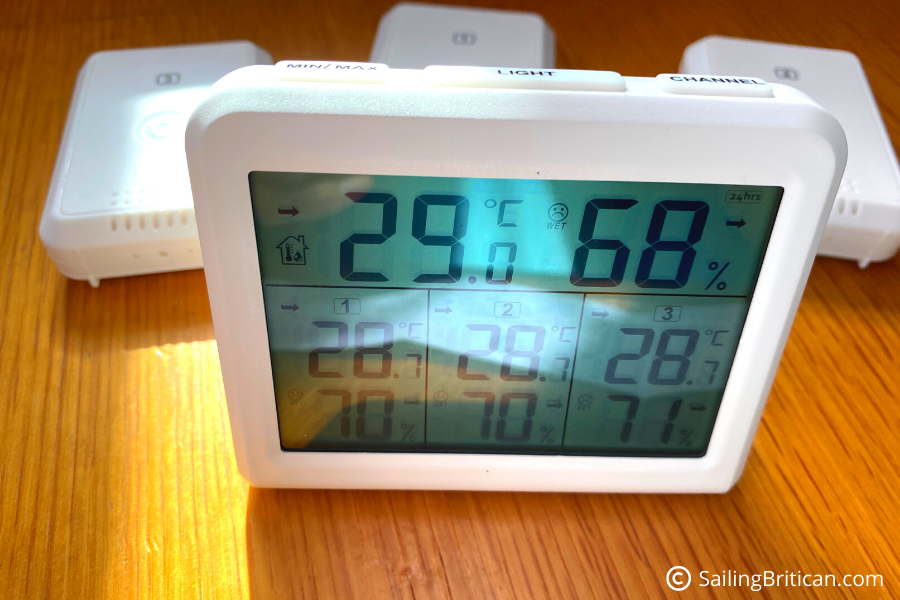
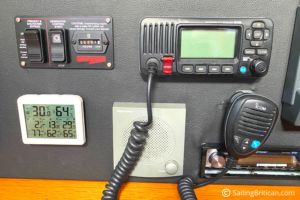
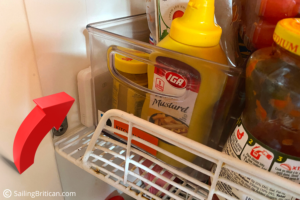

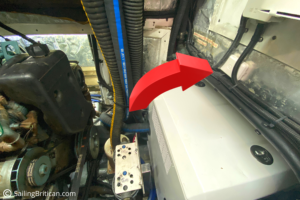
How’s the battery life on the sensors in the cold?
I really don’t know that answer to that Jim. Perhaps you can ask someone that has more experience with sensors. We’ve been in the tropics for years so we never get cold 🙂 Kim